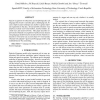26 search results - page 3 / 6 » Modeling Morphologically Rich Languages Using Split Words an... |
ACL
2011
12 years 11 months ago
2011
This paper extends the training and tuning regime for phrase-based statistical machine translation to obtain fluent translations into morphologically complex languages (we build ...
ICASSP
2009
IEEE
13 years 11 months ago
2009
IEEE
Speech recognition of inflectional and morphologically rich languages like Czech is currently quite a challenging task, because simple n-gram techniques are unable to capture impo...
IJCNLP
2005
Springer
14 years 27 days ago
2005
Springer
In this paper, we present an empirical study that utilizes morph-syntactical information to improve translation quality. With three kinds of language pairs matched according to mor...
CORR
2002
Springer
13 years 7 months ago
2002
Springer
We present two methods for unsupervised segmentation of words into morphemelike units. The model utilized is especially suited for languages with a rich morphology, such as Finnis...
CLEF
2009
Springer
13 years 8 months ago
2009
Springer
In biological sequence processing, Multiple Sequence Alignment (MSA) techniques capture information about long-distance dependencies and the three-dimensional structure of protein ...

